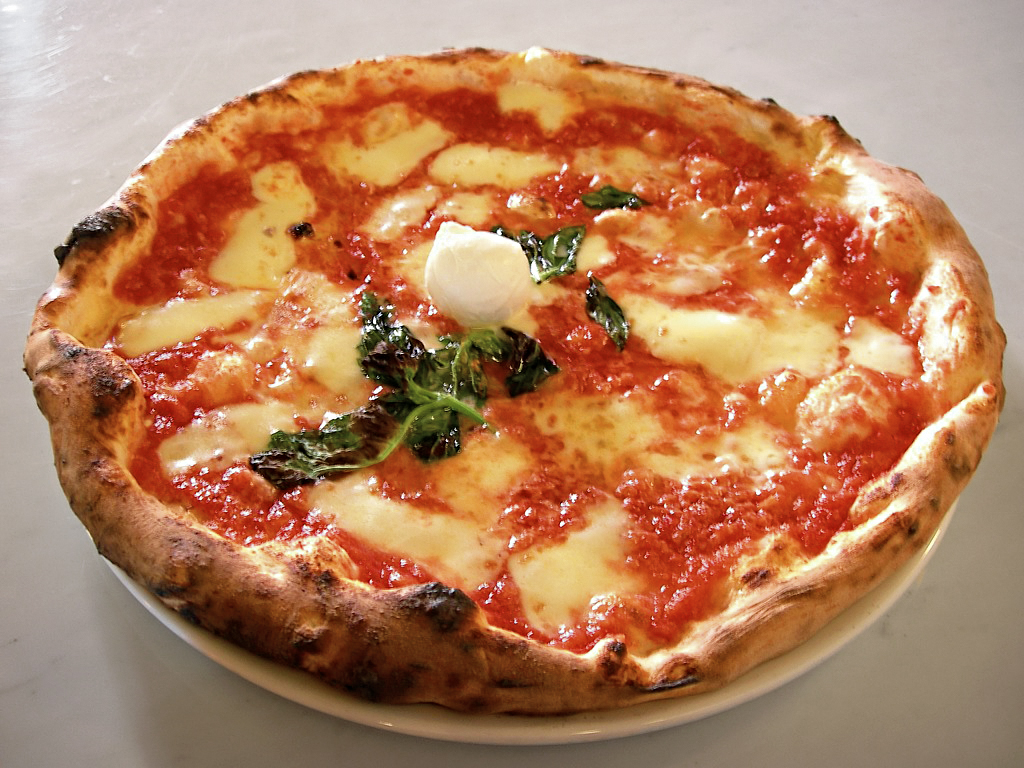Italain Family Stykle Cook for Villa in Floence
In that location are not many nations that can say their national dish has become an international phenomenon. Italy has two such dishes, pasta and, of form, pizza. Both are famous all over the world, and both are role of the history of Italian food. With this post, nosotros'll follow the history of Pizza, the origin, and where it evolved!
The history of Pizza

In America pizza unremarkably falls into two categories: thick and cheesy Chicago style or thin and more traditional New York pizza. In Italy pizza too falls into 2 singled-out categories: Italian pizza and the rest of the earth. It might seem empty-headed because the basic ingredients, only i taste of a true Italian pizza and that'south it. You will never feel the same about this simple and succulent nutrient again. Let's larn a footling chip more about the history of pizza, shall nosotros?
Pizza in its most basic form as a seasoned flatbread has a long history in the Mediterranean. Several cultures including the Greeks and Phoenicians ate flatbread fabricated from flour and water. The dough would be cooked by placing it on a hot stone and then seasoned with herbs. The Greeks called this early pizza plankuntos and it was basically used every bit an edible plate when eating stews or thick goop. It was not yet what we would telephone call pizza today merely it was very much like mod focaccia. These early on pizzas were eaten from Rome to Egypt to Babylon and were praised by the aboriginal historians Herodotus and Cato the Elder.
The origin of pizza
Then, well-nigh the origin of pizza… The word "pizza" is idea to have come from the Latin word pinsa, significant flatbread (although there is much debate about the origin of the word).
A fable suggests that Roman soldiers gained a taste for Jewish Matzoth while stationed in Roman-occupied Palestine and developed a similar food subsequently returning domicile. However, a recent archeological discovery has institute a preserved Bronze Age pizza in the Veneto region. By the Middle Ages, these early pizzas started to take on a more mod look and taste.
The peasantry of the fourth dimension used what few ingredients they could get their hands on to produce the modern pizza dough and topped it with olive oil and herbs. The introduction of the Indian Water Buffalo gave pizza another dimension with the product of mozzarella cheese. Even today, the utilise of fresh mozzarella di buffalo in Italian pizza cannot be substituted. While other cheeses take fabricated their mode onto pizza (usually in conjunction with fresh mozzarella), no Italian Pizzeria would ever utilize the dried shredded type used on and then many American pizzas.

The introduction of tomatoes to Italian cuisine in the eighteenth and early 19th centuries finally gave the states the true mod Italian pizza. Even though tomatoes reached Italy by the 1530's information technology was widely idea that they were poisonous and were grown only for ornament. However, the innovative (and probably starving) peasants of Naples started using the supposedly mortiferous fruit in many of their foods, including their early pizzas.
Since that fateful day, the world of Italian cuisine would never be the aforementioned, however, information technology took some fourth dimension for the rest of guild to accept this rough peasant food. In one case members of the local aristocracy tried pizza they couldn't get plenty of it, which past this time was beingness sold on the streets of Naples for every repast. As pizza popularity increased, street vendors gave way to actual shops where people could order a custom pizza with many dissimilar toppings. By 1830 the "Antica Pizzeria Port'Alba" of Naples had become the first true pizzeria and this venerable institution is still producing masterpieces.
More about the origin of pizza?
The pop pizza Margherita owes its name to Italy's Queen Margherita who in 1889 visited the Pizzeria Brandi in Naples. The Pizzaiolo (pizza maker) on duty that day, Rafaele Esposito created a pizza for the Queen that contained the iii colors of the new Italian flag. The red of tomato, white of the mozzarella, and fresh dark-green basil, was a hit with the Queen and the remainder of the world. Neapolitan style pizza had now spread throughout Italy and each region started designing its own versions based on the Italian culinary dominion of fresh, local ingredients.

Neapolitan pizza is non only special for its relevance in the history of the dish, but also because, since 2010, it holds a STG qualification granted by the EU. STG means that Neapolitan pizza, or Pizza Verace Napoletana, every bit it is known (original Neapolitan pizza), is a specialità tradizionale garantita (guaranteed traditional specialty): its ingredients are controlled and regulated by law, just as its shape, the mode the dough is prepared and cut, and where it can exist consumed.
Yep, that's right: to be and so, a pizza verace napoletanamust be consumed in the same premises where it has been baked, which ways have-out pizzas lose their STG qualification. The STG qualification is a guarantee for the consumer that the product roots its origins in the culinary tradition of a certain area and, fifty-fifty more of import, that information technology has been made following regulations apt to keep the Neopolitan pizza authentic.
Traditional Italian pizza
Continuing the history of pizza, we should have a await at the traditional Italian pizza too. Pizza Margherita may have fix the standard, but there are numerous popular varieties of pizza fabricated in Italy today.
Pizza from a Pizzeria is the recognized round shape, made to lodge, and always cooked in a wood-fired oven. Regional varieties are always worth trying such as pizza Marinara, a traditional Neapolitan pizza that has oregano, anchovies, and lots of garlic. Some other traditional Italian pizza is:
Pizza Capricciosa with a topping of mushrooms, prosciutto, artichoke hearts, olives, and ½ a boiled egg! Pizza Pugliese makes use of local capers and olives, while pizza Veronese has mushrooms and tender prosciutto Crudo. Pizzas from Sicily tin can take numerous toppings ranging from dark-green olives, seafood, hard-boiled eggs, and peas.
Besides regional styles, in that location are several varieties that are popular throughout Italy. Quattro Formaggi uses a 4-cheese combination of fresh mozzarella and 3 local kinds of cheese such as gorgonzola, ricotta, and Parmigiano Reggiano, or stronger cheeses such as fontina or taleggio, depending on the areas of Italy. Italian tuna packed in olive oil is also a popular topping along with other marine products like anchovies, shellfish, and shrimp.
Quattro Stagioni is another traditional Italian pizza like to the Capricciosa. Information technology represents the four seasons and makes a proficient sampler pizza with sections of artichokes, salami or Prosciutto Cotto, mushrooms, and tomatoes. In Liguria, you may find pizza topped with basil pesto and no tomato plant sauce. Of grade, in that location are hundreds more to discover and all of them are delicious!
New Trends in Pizza and types of flatbread
Inside the history of pizza, and the traditional Italian pizza, there are other types of pizza and types of flatbread that are very popular in Italy (and not only). Here are some highlight!
Pizza al taglio,also known equally pizza rustica, is sold everywhere in Italy, usually by weight and oftentimes piled with marinated mushrooms, onions, or artichokes. This way of pizza is cooked on a sheet pan at street stalls and makes a good quick lunch.
Focaccia is typical of Liguria and is characterized past a base usually thicker than that of pizza, topped with olive oil and rosemary. More toppings can be added, olive, caramelized onions, and cheese beingness among the more common.
Sfincione is a thick Sicilian sheet pizza that uses tomato sauce, anchovies (usually anchovy paste) breadcrumbs, and caciocavallo (or another local variety) cheese.
Italian calzone (no surprise hither!) is smaller than its American cousin and is often filled with either meats or fresh vegetables (a favorite is a spinach) and mozzarella. A newer trend that is gaining popularity is the emergence of sugariness pizzas and traditional Italian pizzerias are trying to accommodate this trend by using unique ingredients. These dessert pizzas ofttimes accept flavor combinations such as Nutella, love, fruit jam, yogurt, even mustard, and liquor.
One thing to keep in mind when ordering pizza in an Italian pizzeria is that the product is personal size. Each person at a table should guild their own individual pizza – one bite will explicate why. In certain areas outside Italy, there are a few pizzaioli who go along to their homeland traditions as best as they tin with the ingredients they take, but it really isn't the aforementioned. In the end, at that place is no going dorsum one time you try a existent Italian pizza, no delivery or frozen product will e'er stimulate your taste buds the way a real Italian pizza does!
These would be our highlights of the history of pizza, the traditional Italian pizza and the different types of pizza you can find. We hope y'all're ready to taste and love.
By Justin Demetri
- See also :
- How to make pizza at domicile
- Pizza Margherita is 120 years onetime
- History of Italian food
Notation: since 1 reader posted that in Napoli pizza Margherita is made with Fior Di Latte (Cow Mozzarella) and not Buffala mozzarella I did some enquiry and it looks similar the reader is wrong. One of the most famous Neapolitan pizzeria (L'Antica Pizzeria da Michele) uses buffalo mozzarella and I suspect all exercise, I exercise not encounter how they could do otherwise since buffalo mozzarella comes from the Naples expanse and it has always been considered superior to Fior di Latte.
Source: https://lifeinitaly.com/history-of-pizza/
0 Response to "Italain Family Stykle Cook for Villa in Floence"
Post a Comment